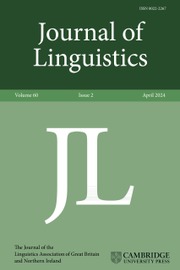Article contents
How to do things with junk: exaptation in language evolution1
Published online by Cambridge University Press: 28 November 2008
Extract
One of the less rewarding of our common interdisciplinary pursuits is lifting theoretical concepts from subjects not our own, and using them in contexts very distant from those they were intended for. Such borrowings often turn from theoretical claims into sloppy metaphors, leading to varieties of ‘vulgar X-ism’, the resuit of overenthusiastic appropriation with insufficient sense of the subtlety or precise applicability of the originals. Spencer's ‘Social Darwinism’, vulgar-Freudian or vulgar-Marxist literary analysis and sociology are nice examples. Linguistics, being less unique than linguists often think, is no exception: Praguian and neo-Praguian functionalism may be a kind of vulgar Darwinism, extending notions of ‘adaptation’ or ‘selective pressure’ to the inappropriate domain of language Systems (see Lass, 1980a). But every once in a while such transfers seem to work, like Darwin's borrowings from late eighteenth-century Scottish economie theory; if not always through direct applicability, then by focusing on new ways of interpreting old data, or providing a basis for linking disparate phenomena as instances of a new (putative) natural kind.
Information
- Type
- Articles
- Information
- Copyright
- Copyright © Cambridge University Press 1990
References
REFERENCES
- 205
- Cited by

